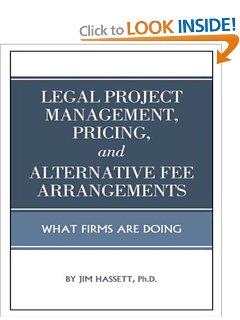http://www.patrickmckenna.com/blog
Page << Prev 30 31 32 33 34 35 36 37 38 39 Next >> of 95
Rant #661 - Wednesday, April 3, 2013
Spring 2013 Issue of International Review Is Now Available
 Here’s my newest issue of International Review – an issue that I hope contains a balanced blend of thoughtful insight and practical contributions on law firm strategy and leadership. Here’s my newest issue of International Review – an issue that I hope contains a balanced blend of thoughtful insight and practical contributions on law firm strategy and leadership.
Today, I believe we face a time when doing things fundamentally differently will ultimately trump doing the same things more efficiently. To succeed firms will need to focus increasingly more attention on how they might differentiate themselves in ways that client value. My Six Elements of Meaningful Differentiation is intended to provoke your thinking on this important topic. And you may note that while this may not be the most comprehensive piece on this subject I have deliberately not identified costs as a significant differentiator. For those who engage in predatory pricing, you might win the fee-cutting race . . . right to the bottom - but the real strategic issue is whether you will have a sustainable practice after you get there.
I am delighted to include an article that American Lawyer magazine agreed to publish an excerpt from earlier this year. Malignant Leadership reflects upon some lessons from the Dewey catastrophe and has probably garnered more responses from readers than almost any other article that I’ve written over the years.
Be sure to have a look at the results of my latest research into the dynamics of being a managing partner as conveyed in Inside The Corridors of Firm Leadership. This expose represents the responses from firm leaders of AmLaw 100, AmLaw 200 and other firms on everything from their job descriptions and how they spend their time to their leadership priorities and intentions for when they leave office.
Finally, I am observing a trend wherein more firms are starting to hit the Reset Button on their practice group management efforts and trying to start fresh. Practice Group Leadership 2.0 is my attempt to prescribe some fundamental structural recommendations for what firms absolutely must do to make their practice management efforts successful.
I sincerely hope that you find some practical ideas, tips and techniques here that you can put to use immediately. To obtain your complimentary PDF copy simply click on the cover of the magazine. Please send me your observations, critiques, comments and suggestions with respect to any of these articles.
Rant #660 – Monday,
April 1, 2013
Once More On Cross-Selling
 The other day on the Managing Partner discussion site (LinkedIn) I
came across a posting wherein some
member was informing us all
that “cross-selling within law firms is broken” and lecturing the
readers that “If a firm is
truly serious, an organizational system should be put in place, driven
by the management board, to facilitate the process straight from the top.” The other day on the Managing Partner discussion site (LinkedIn) I
came across a posting wherein some
member was informing us all
that “cross-selling within law firms is broken” and lecturing the
readers that “If a firm is
truly serious, an organizational system should be put in place, driven
by the management board, to facilitate the process straight from the top.”
I couldn’t
contain myself . . . I was compelled to rant:
I could easily wallpaper my offices with all of the articles that
have been written over the past twenty years on cross-selling, and yet the
behavior doesn’t ever seem to change. And firm leadership taking control or
issuing ultimatums hasn’t worked in the past and is unlikely to work going
forward.
Here are two observations worth exploring.
One is that I rarely see cross-selling being quite such an issue
within industry groups. Industry groups, by their nature, tend to focus much
deeper into all of the various legal issues that clients face, such that it
never feel like you are “selling” anything; but rather endeavoring to prevent
or solve the client’s problems. But unfortunately, we still tend to structure
our firms based on what we studied at law school rather than what the client
wants – us to really know their business.
The second may lie in understanding how to motivate competent and
conscientious lawyers. The process that is most often used in cross “selling”
is that firm management asks the members of some practice group to go to the
other groups and “tell them what you do” because instinctively we know that
product knowledge (knowing what the other lawyers in our firm actually do for
our clients) is pathetic!
The only shortcoming to this approach is that I do not, frankly,
have the patience to listen to you ramble on about all of the various services
that your group provides. And I don’t really understand most of it either. What
would get my attention though, is if you could: (1) succinctly identify only
ONE hot, topical legal issue that my clients might be facing now or in the very
near future;
(2) identify the type of client (perhaps by number of employees)
that this issue is most likely to impact;
(3) tell me in a very brief manner why and how this issue is going
to impact my client; (4) tell me what the downside or consequences might be if
my client does not take some remedial or proactive action; and
(5) give me a written cheat-sheet/script on what I should say to my
client to make them aware of this issue (because frankly, I didn’t go to law
school for all those years to now come across like some used-car salesman and I
don’t know what to say to my client so as not to embarrass myself).
In other words, give me the tools to look competent in serving the
best interests of my clients and I “might” be more interested in engaging in
your cross-selling crap!
Rant #657 – Monday,
March 25, 2013
How You Present Your
Distinctiveness Makes a Difference
 During an
interview with a prospective client you are asked to briefly describe what
differentiates you or your firm from your other competitors. At that
moment your overwhelming goal is to present some distinctive factors that
impress this prospect; so you begin to list some accomplishments. You tell this prospect about how Chambers has
ranked your firm among the first tier providers in Health Care, about how your
practice group has more bio-science PhDs than any other in the region; and how
you currently serve four of the largest five regional hospitals. And then,
almost as an after-thought you mention that you have also just recruited a
leading lawyer in the area of IP and expect to be growing that practice. Not yet an impressive accomplishment, but
since this company is likely to have intellectual property issues, you figure
mentioning that you are moving ahead in this area is better than saying nothing
at all. During an
interview with a prospective client you are asked to briefly describe what
differentiates you or your firm from your other competitors. At that
moment your overwhelming goal is to present some distinctive factors that
impress this prospect; so you begin to list some accomplishments. You tell this prospect about how Chambers has
ranked your firm among the first tier providers in Health Care, about how your
practice group has more bio-science PhDs than any other in the region; and how
you currently serve four of the largest five regional hospitals. And then,
almost as an after-thought you mention that you have also just recruited a
leading lawyer in the area of IP and expect to be growing that practice. Not yet an impressive accomplishment, but
since this company is likely to have intellectual property issues, you figure
mentioning that you are moving ahead in this area is better than saying nothing
at all.
Or is it?
According to the
work of Dr. Heidi
Grant Halvorson, a social psychologist who researches, writes, and speaks about
the science of motivation – it
isn’t. You’ve just fallen victim to a phenomenon that she says psychologists
have recently discovered, called the “Presenter’s Paradox.” It’s a fascinating example of how our
instincts about presenting – ourselves, our firms, or our service offerings –
can be surprisingly bad.
In essence, our
erroneous assumption is this: when we present a prospect with a list of our
accomplishments (or with a bundle of services), that they will see what we’re
offering additively. If our Chambers rating, our PhDs and our
hospital clients are all a “10” on the scale of impressiveness, and our
burgeoning commitment to IP is a “2,” then we reason that added together, this
is a 10 + 10 + 10 + 2, or a “32” in impressiveness. So it makes sense to
mention your minimal IP experience to the overall picture. We just assume
that more is better.
Only more is not
in fact better to the prospective client.
Research shows
that this is not how other people see what we’re offering. They don’t add
up the impressiveness, they average it. They look at the package
as a whole, rather than focusing on the individual parts. To them, this is a (10+ 10+ 10+ 2)/4 package,
or an “8” in impressiveness. And if you had left off the bit about your
IP initiative, you would have had a (10 + 10+ 10)/3, or a “10” in
impressiveness. So even though logically it seems like a little IP
is better than none, mentioning it makes you a less attractive candidate than
if you’d said nothing at all.
The challenge here is to recognize that more is actually not
better, IF what you are adding is of lesser quality than the rest of your
offerings. So if you are an employment
lawyer practicing in the firm with the accomplishments I just mentioned, but
your particular group has little to mention by way of first tier achievements,
you are better off presenting the firm’s big picture accomplishments then
trying to finesse something of lesser status.
In other words, your highly favorable or positive attributes are
diminished and diluted in the eye of the beholder (the prospective client) when
they are presented amongst only moderately favorable achievements.
If this bias in how we present ourselves is so pervasive,
how can we stop ourselves from making this kind of mistake? According to Dr. Halvorson, we need to constantly
remind ourselves when making any kind of presentation to think holistically.
How distinctive is the
package I’m presenting, taken as a whole, and are there any elements that take
away from or dilute the impressiveness and overall value?
Three 10’s and a 2 is not better than three
10’s.
Rant #658 – Tuesday, March
19, 2013
How Confident Are You That We’re
Seeing An Improved Picture?
According
to the latest Law Watch Managing Partner Confidence Index survey, released this
week by Citi Private Bank's Law Firm Group those surveyed (only 77 firm leaders)
are feeling more confident. In a
subsequent discussion with my fellow co-author and favorite law firm finances
analyst, Ed Reeser, I obtained this insightful analysis:
As we recall, the
first quarter of 2012 started off with some vigor, and then things went into
the tank in the second quarter and continued rather poorly into the third. Only
an unexpected and marvelously active fourth quarter, both in terms of work and
collections, appears to have saved the 2012 calendar year. Specifics on how,
when and from where this rebound came are to this point anecdotal and a bit
vague, as the information has come from preliminary reports. Greater details are eagerly awaited, as
through the end of November the impressions were not positive for the fourth
quarter of 2012.
 There are some
seriously inconsistent responses within this survey. Heavy discounting (100%) and expectations of
increased costs (72%) are in the same report as increased profits expectations
(75%). How can one reconcile those contrasting
forces? There are some
seriously inconsistent responses within this survey. Heavy discounting (100%) and expectations of
increased costs (72%) are in the same report as increased profits expectations
(75%). How can one reconcile those contrasting
forces?
First,
there is revenue growth . . . and indeed 85% of the respondents have
expectations of revenue growth. How are
they going to get it in a market that Citibank says is characterized by
"not enough legal work to go around"?
There is organic
growth from within, which has been lacking for most firms, but perhaps with a
recovering economy that could go up and help much larger numbers of firms. Obviously that would be great, and indeed 93%
are looking to conditions that are the same or better than last year. That is pretty optimistic considering that Q4
was perhaps the biggest unexpected miracle result since the US defeated the
Russians in hockey at the 1980 Olympic Games, and without it the year was
pointing towards a serious disappointment.
There is
buying growth through lateral hires . . . a strategy that recent reports
from Professor Henderson and Chris Zorn at Lawyer Metrics on the US side of the
Atlantic, and Mark Brandon on the UK side of the Atlantic . . . have shown to be
a failing one most of the time.
Second,
there is removal of participants in the profits pool and
increase leverage, This approach is evident in the FTE chart on
non-equity partner growth expectations. Of
the three tactics, only this last one of self-consumption is absolutely
available and consistent with proven past behaviors and results. Not for all firms. But for a very large number it has
characterized their performance in 2012, and more of the same should be
expected.
This report is like
a finger, pointing to the moon. The
finger has strongly optimistic expectations of greater demand, overall
confidence, stronger economy, stronger business conditions for the law, rock
and roll profits, and increased revenues.
But the focus should
not be upon the finger – it is about where the finger is pointing. Strip away
the aspirational and 'hoped for' expectations, and lift the gaze to where the
substantiated components of the report based on past performance lead your
vision . . . stagnant demand, heavy discounting, increased costs, reduced
partner head-counts.
What do you see?
Rant
#657 – Tuesday, March 19, 2013
IBM
Asks Students To Choose Watson's Next Job
 After famously winning Jeopardy!
in 2011, IBM's supercomputer Watson helped healthcare professionals improve the
speed and quality of treatment for cancer patients. Now, the technology
corporation is turning to the next generation to help determine where Watson
should work next. After famously winning Jeopardy!
in 2011, IBM's supercomputer Watson helped healthcare professionals improve the
speed and quality of treatment for cancer patients. Now, the technology
corporation is turning to the next generation to help determine where Watson
should work next.
More than 100 University of Southern California
students competed in the IBM Watson Academic Case Competition to apply the
supercomputer to challenges in business and society. With only 48 hours to
create a new purpose for Watson, 24 teams presented business plans to a panel
of IBM executives, industry leaders and school officials.
The winning idea implemented Watson in LEGAL RESEARCH, proposing
the computer build the research for cases. Watson's quick response and ability
to parse complexities in the human language would allow it to sort through
evidence and forecast the probability of success. By using the supercomputer,
legal firms would be able to save money and time, and pair it with smarter
outcomes.
Rant #656 – Thursday, March 14, 2013
As A Firm Gets
Larger Does It Mean Looking More Conservative, Bland and Sterile?
Last week I had the
ocassion to meet with the Management of an AmLaw 100 firm at their home
office. Upon entering Reception I was
directed to a huge area with multiple couches and coffee tables. This space could have easily welcomed dozens
of people; but it was anything but welcoming!
 There were no
newspapers, books, firm brochures or reading materials of any kind; absolutely
nothing on any of the coffee tables.
Walking around this huge space I noticed, receding into the wall at the
corners of the room, a slanted shelf with a couple of magazines. The first one I selected was ‘Chief Executive
Magazine,’ one I thought absolutely appropriate to those I might expect to
frequent this firm’s office. Only one
small shortcoming. This particular issue
was dated - November 2010. There were no
newspapers, books, firm brochures or reading materials of any kind; absolutely
nothing on any of the coffee tables.
Walking around this huge space I noticed, receding into the wall at the
corners of the room, a slanted shelf with a couple of magazines. The first one I selected was ‘Chief Executive
Magazine,’ one I thought absolutely appropriate to those I might expect to
frequent this firm’s office. Only one
small shortcoming. This particular issue
was dated - November 2010.
Wandering over to
the other shelf I found a magazine with the huge headline: "America’s Best
Law Firms" on the cover. It was an
issue of 'Corporate Board Member' which reports their annual assessment of the
legal industry. This particular issue
was more recent – second quarter of 2011.
I assumed it was probably on display because it profiled the firm I was
visiting. Wrong. This firm was not listed among the best! Indeed one might conclude that they were
promoting their competition.
Upon reflection, I
realized that my experience here, was not isolated to this firm but consistent
among many large firms that I’ve visited.
It reminded me of a General Counsel I heard speaking at a conference
many years ago. Prominent in the
financial services industry, he oversaw dozens of outside law firms. During the question period he was asked
whether any of the firms that he used happened to stand out, for whatever
idiosyncratic reason, in his mind. He
paused for a moment and then said, yes, one firm indeed stood out. He was then asked why. My mind immediately went to the likelihhod of
him telling us about the firm’s expertise or significant legal
accomplishments. But that is not at all
what we heard.
“These folks truly
understand how to manage the client’s impressions and expectations. By way of one small example, whenever I
arrive at this firm’s offices, I note that they have two receptionists. They don’t need two, but the second one comes
out from her desk to greet me, always by name.
She doesn’t necessarily know me, but in this firm it is mandatory for
every attorney to advise Recption of expected visitors; what time they are
expected, their name, which company they are from and provide a picture or
description of what they look like. I’m
then taken to get my beverage of choice, usually a capaccino or freshly
squeezed orange juice, and escorted to a seating area that resembles your
typical living room – comfortable chairs, beautiful lamps, interesting and
unique reading materials; including one binder which contain press clippings
highlighting some of the firm’s various community activities, industry
initiatives and awards, and another binder which features some of the firm’s
most recent articles and newsletters.
There are flowers, bowls of candy, fresh fruit, boxes of kleenex, and a
basket of umbrellas that you are welcome to use should it be raining by the
time your meeting has concluded. And
that receptionist who greeted me is available to suggest and make lunch,
dinner, theater or other reservations to fit my needs while I’m in town.”
When I reflect upon
that story and compare it to the sterile environment that I encountered, I
wonder if it might not be time to invite some neutral third-party to visit your
office . . . and then candidly report back to you on just how welcoming and
comforatble they found the experience.
AM I BEING TOO SIMPLISTIC HERE? Do sophisticated
clients really expect to confront a highly conservative rather than a welcoming
living-room environment when they visit a law firm?
Rant # 655 – Wednesday, March 12, 2013
Two New Books Worthy Of Your Attention
 I have been a fan of
Jim Hassett and his project management work for some years now and am honored
to participate (as one of only 2 consultants) on his 58-member Project
Management Advisory Board, so I will declare my bias upfront. That said, you really should take a look at
Jim’s latest work – Legal Project Management, Pricing, and Alternative Fee
Arrangements. This book describes what leading law firms are doing to transform the way
they plan, manage, and price legal work. I have been a fan of
Jim Hassett and his project management work for some years now and am honored
to participate (as one of only 2 consultants) on his 58-member Project
Management Advisory Board, so I will declare my bias upfront. That said, you really should take a look at
Jim’s latest work – Legal Project Management, Pricing, and Alternative Fee
Arrangements. This book describes what leading law firms are doing to transform the way
they plan, manage, and price legal work.
It begins by describing how the legal profession is
changing, and explains why legal project management is so important to future
success. The book contains reports from
lawyers in the trenches who have used these techniques to plan their projects
efficiently, develop budgets, price their legal work appropriately, and gain
advantages over their competitors.
Jim describes eight key issues in legal project
management and reviews a number of case studies to illustrate the wide variety
of approaches that different firms are taking to change lawyers behavior. He then discusses the theory behind changing
models of law firm pricing, and what leading firms are actually doing in
practice, including alternatives to the traditional billable hour. The text concludes with a list of 10 key
recommendations to help law firms adapt to the changing marketplace.
 The second book, Targeting Profitability: Strategies To
Improve Law Firm Performance is one that I’m delighted to have contributed a
chapter to - entitled "How to differentiate in a way that is meaningful to
clients" The second book, Targeting Profitability: Strategies To
Improve Law Firm Performance is one that I’m delighted to have contributed a
chapter to - entitled "How to differentiate in a way that is meaningful to
clients"
Law firms are increasingly looking at new ways to drive
profitability. However, research shows
that they are still not maximizing the potential of both clients and staff. As a result, Managing Partner has brought
together the sought-after advice of industry experts to provide you with
practical tips on specific methods which can be used to increase the
profitability of your firm.
From clients, people, and training, to finance, billing,
and IT, Targeting Profitability
highlights the key areas that can be improved. Useful strategies are provided to help you
increase your law firm's profitability along with the key steps you need to
consider when implementing them.
More information - http://www.managingpartner.com/bookshop/targeting-profitability-strategies-improve-law-firm-performance
Rant #654 –
Wednesday, March 6, 2013
Would Your Firm Openly Disclose Its
Financials?
 K&L Gates has pledged to keep the firm's accounting
books open regardless of the numbers and put the onus on other firm leaders to
reconsider public disclosures. K&L Gates has pledged to keep the firm's accounting
books open regardless of the numbers and put the onus on other firm leaders to
reconsider public disclosures.
In a news advisory, K&L Gates announced its 2012 Financial
Results on the firm’s website, complete with a detailed balance sheet including
revenues, cash balances, bank debt, pension obligation percentages and even
revenues by region. According to a story on Law360, chairman Peter Kalis
claimed, "We're prepared to embrace this quality of disclosure as a
continuing part of our business. It will be a reflection of our business in
good times and bad?"
Kalis singled out AmLaw's yearly survey and firm
rankings as another impetus for change, saying the publication engaged in the
same kinds of secrecy as many firms by not disclosing the source of firm data
or saying which firms did not voluntarily provide data. He called the
widely-read rankings "an important part of the legal culture," but
one that bypassed critical questions about debt, liquidity and retirement fund
obligations. "Law firms die because of impaired balance sheets, and the
surveys never ask those questions," Kalis said. "It's the balance
sheet issues that go to the heart of institutional stability.
Kalis said the response from clients and partners has
been overwhelmingly positive, but declined to make a prediction on whether
other firms would follow suit.
What effect will this kind of transparency have on the
profession? Do you think clients care about a law firm’s financial
transparency? Would your firm be prepared to disclose its financials? 
COMMENT RECEIVED: My reaction to reading this article was 'Holy Smokes'. Not because it will have a material transparency impact on the profession, because to a large extent, it won't in my expectations happen. Nor do I think clients will care much about law firm financial transparency. Indeed to some extent, while I agree with his point that balance sheet information is critically important, it is far from being dispositive of the question whether a firm is secure and stable financially or not, for which I have published several articles specifically addressing that very point.
But at least two things are going on. One thing, he just took on AmLaw nose to nose on several points. First point being the data is incomplete and conclusions drawn incorrect...but it is widely read and relied upon. Ouch. Second point being it is no longer debatable, Dewey proved that law firms game the numbers, and everybody knows it. Ouch. However it is the Second thing that really shakes things around. He is making a strategic move to distinguish his firm in a very tough competitive market for talent, particularly against vereins and other firms modeled like his for global footprint, by using 'financial transparency' as a competitive tool. By saying nobody can trust AmLaw surveys, apart from getting knocked off their holiday card list in perpetuity, he puts it to the industry players to prove up their financial position with public numbers they stand behind directly. And by saying most firms should be able to do this, now they can prove up. But give it a couple of months, and phase two will come, which is those that have not stepped up obviously have not because they cannot prove up. Why consider joining that firm when you can come with us? And that means.....any MP and his/her firm that doesn't do so is tarred by implication with being a "Dewey", with being a firm that may be 'gaming' the surveys in which they participate....indeed they gave the order for the "Code Red", with words like "PPP" and "RPL" and "Productivity" and "Margin" instead of the ones in this clip that pretty much puts Mr. Kalis in the shoes of Mr. Tom Cruise:http://www.youtube.com/watch?v=5j2F4VcBmeo
This could be an interesting few weeks to come. - Edwin Reeser
Post #653 – Friday, March 1, 2013
Revisiting The Performance Consequences of Leadership Tenure
 In the March issue of Harvard Business Review, there is a fascinating article
entitled Long CEO Tenure Can Hurt
Performance authored by a professor at the university of Texas and two PhD
candidates. It summaries the results
from a study of 356 U.S. companies
from 2000 to 2010. The conclusion
– long tenures diminish returns. In the March issue of Harvard Business Review, there is a fascinating article
entitled Long CEO Tenure Can Hurt
Performance authored by a professor at the university of Texas and two PhD
candidates. It summaries the results
from a study of 356 U.S. companies
from 2000 to 2010. The conclusion
– long tenures diminish returns.
The findings
suggest that Boards should be aware that long-tenured CEOs may be skilled at
employee relations but less adept at responding to the marketplace. These leaders may be great motivators but
weak strategists. The researchers arrive
at an optimal tenure length . . . 4.8 years!
In my 2009 article for American Lawyer entitled Tenure Trap, I reported on how over 40 years ago, two sports researchers reported
on a research finding that has significance to any debate on leadership
tenure. These two academics found, from
a large sampling of college basketball coaches, that a relationship actually
exists between coaching tenure and team performance. The duo discovered that the longer the
coaching tenure, the greater the team success.
However, after a certain period – 13 years on average, the team’s
performance consistently began to decline . . . steadily.
Fast forward nearly
twenty years and in 1991 two Columbia University professors, Hambrick and
Fukutomi building upon this initial research, proposed a model outlining five
discernable phases in the evolution of a CEO’s tenure in office. Their research demonstrated that in the first
phase the leader is working to develop an early track record, legitimacy and a
political foothold. This is followed by
a period where the incumbent has achieved small successes and established credibility
sufficient to be willing to consider exploring new directions. In the third phase the leader tends to select
a theme for how the firm should be configured and run from that point on – in
other words, the leader selects those elements that seem to work the best and
that are the most comfortable. By the
fourth phase a period of refinement occurs wherein only a few new changes are
made and those changes are largely designed to fine-tune earlier
directions. At some point, job mastery
gives way to boredom; exhilaration to fatigue; strategizing to habituation.
Inwardly the leader’s spark becomes dim and responsiveness to new ideas
diminishes. Thus the primary
risk to any firm from having an overly long-serving firm leader can be malaise
and lethargy.
My most recent research, just completed in January (and soon
to be published – Inside the Corridors of
Firm Leadership) shows that the average tenute today for firm leaders is 9.8 years; although I did hear from 12 incumbents who have
thus far served over 15 years and another two who had served over 30 years in
the role.
I remember
something that Harry Trueheart, the former Chairman of Nixon Peabody
told me; “one assumes a skilled leader can and should go on indefinitely
despite the trajectory of the organization - not a sound premise. Law firms in particular need to renew and
refresh themselves, develop talent for the future, assure a continuity of
leadership talent and a broader pool from which to pick. So the process naturally requires renewal and
there is a cycle. The length of the
cycle may vary and we could have an interesting discussion about optimum
lengths. I would say any firm leader who
cannot sustain for 6 years in not a good pick. If the firm can get more, then they have found
a good one - say nine. Depending on when
a person starts the job, the next question is what does the firm do with them-
after 6 or 9 more years. It is a
probability of law firm life that leaders who have been in the job long enough
to see their practice waste away and find themselves in middle age or in a harsh
political environment, must leave the firm to survive. So firms may want to take that into account. More than a decade of service is an accident
of circumstance, luck and skill coming together.”
Rant #652 – Friday, March 1, 2013
Leadership Mentoring
I’m pleased to be participating, for the second year, as a
Law Firm Leadership Mentor and one of only nine individuals in North America,
for the Mentoring Programme established by the International Bar Association.
The aim of the Mentoring Programme is to
provide law firm management advice and guidance to lawyers who do not have easy
access to management consultancy services. The first version of this Programme
was launched by the Law Firm Management Committee in 2009 as a pilot programme
available to IBA members.
For more information: http://www.ibanet.org
Page << Prev 30 31 32 33 34 35 36 37 38 39 Next >> of 95
|


 Ashridge House
Ashridge House  11226 - 60 Street
11226 - 60 Street  Edmonton, Canada
Edmonton, Canada  T5W 3Y8
T5W 3Y8